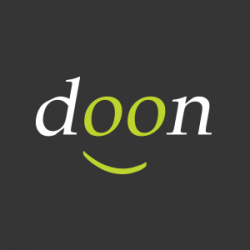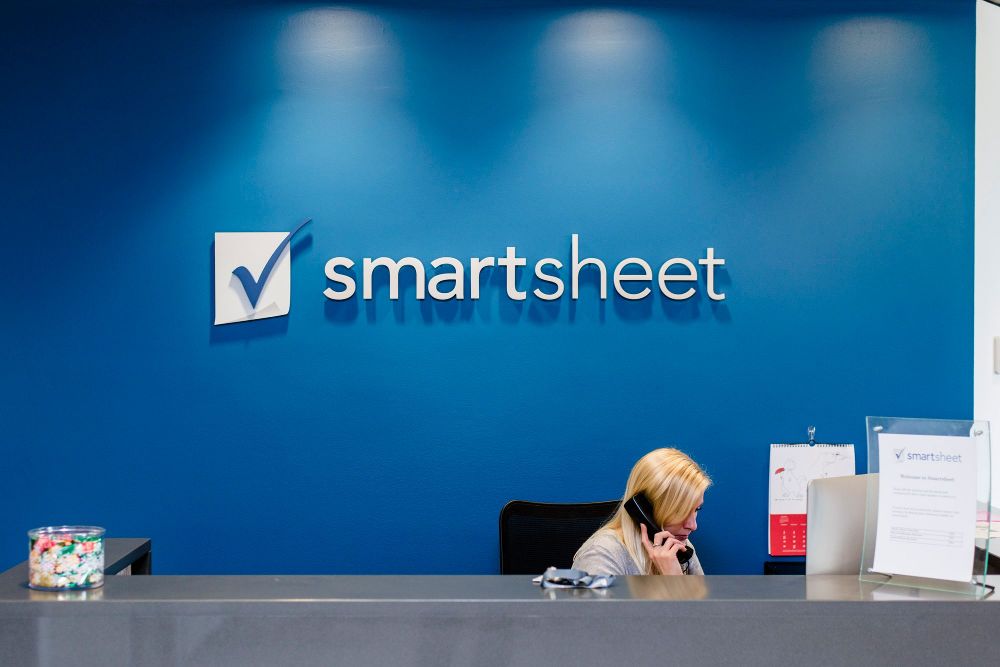Company: Smartsheet
Role: Vice President of Experience Design
Dates: August 2020 – August 2022
Situation
I came in just as work on our visual refresh was wrapping up. There was no implementation or maintenance plan for it. The overall team was at about 35 people and stretched thin across 30+ pillar teams. The team was burned out. Leadership was fragmented and siloed. There was no structure for growth, no career ladders, and few functioning design processes in place. The experience around customer needs (addressing an outdated mental model, heavy cognitive load, confusing navigation) and business needs (higher design quality) were diverging. OG design leaders all hit their 4-year RSU vesting period simultaneously and began quitting. Design Maturity in the organization was good, but a holistic product development approach was lacking. Relationships between UX, Product, and Engineering were strained.
Task
What’s the saying? “What got you here won’t get you there.”
The task at hand: reframe, restructure, refresh, and reboot a team of non-traditional designers, researchers, and writers. Add missing skills and capabilities in order to take the Smartsheet Experience Design team into the future.
Actions
I defined a 30-60-90 (listen-think-act) approach to understand the problems and reorganize the team to better align with business goals and processes while driving changes to product development processes.
What I did:
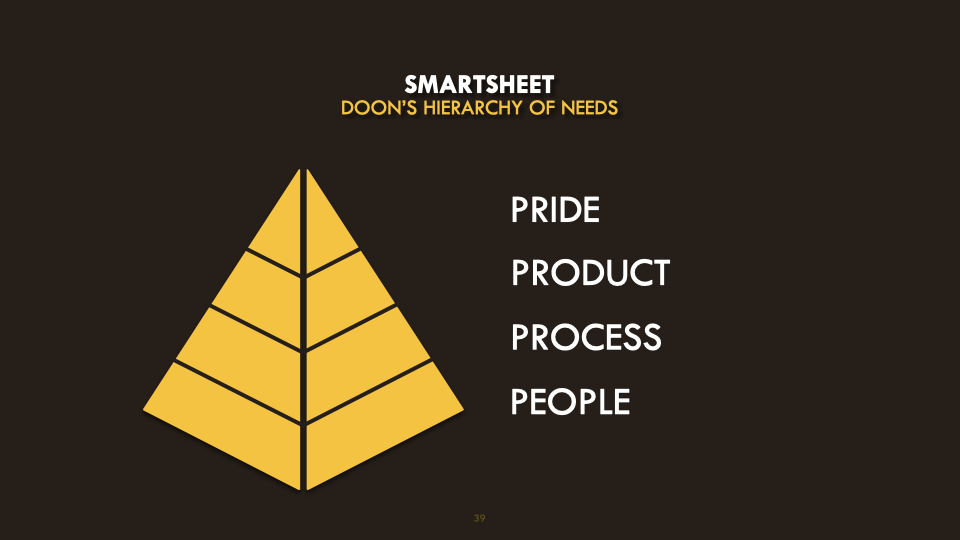
Every company is built on the bedrock of their Purpose or value proposition. From there, you build up.
- People: I had to understand if we had enough people, the right people with the right skills, and people with the right attitude (and who still wanted to be there through the transition).
- Process: With the right people in place, I needed to determine if we had the structures (i.e. org), processes, and rituals (i.e. design critiques) for the team to be effective. I also needed to revisit the processes for how the team worked with Product and Engineering.
- Product: With the ability to work effectively in place, I could begin tackling the areas of the product that needed attention (e.g. implementing and maintaining our new design system, rearchitecting our information architecture and mental model, making key product areas accessibility compliant)
- Pride: The “self-actualization” tip of the pyramid had to do with bringing the team’s unique character into focus, giving it an identity, and something to be “known for.”
The challenge here was that we couldn’t wait until the “lower levels” of the pyramid were in place before taking on the product work. I had to “MVP” this approach and take a slice from top to bottom and do a bit of everything. Knowing what “everything” was and what we were going to prioritize and focus on was critical. Having great leaders helped.
I looked at where Smartsheet was going (our three-year plan) and organized the team to continue delivering “today” work while establishing new pillars to set us up for “tomorrow” work.
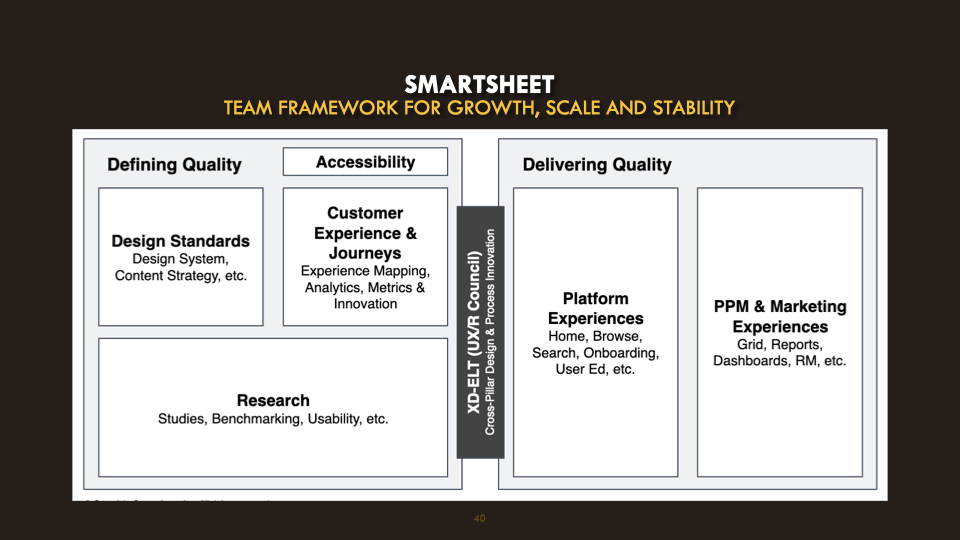
In the diagram above, the left side of the Design team was tasked with defining “what good looks like.” We needed more than just usability (e.g. can people use it?) and desirability (e.g. do people want it? find it appealing?); our experiences also needed to deliver real value to both our customers and bottom line.
I hired a Director to establish and build out a team to take the newly defined “visual design language” and turn it into a Smartsheet Design System (and to operationalize and maintain it). Additionally, I took over our Accessibility program (from the Product team) and folded it into the planning and design of our design system components and patterns. I hired a Director to establish a team to focus on defining and measuring the quality and performance of our experiences (i.e. customer journey analytics). Lastly, I hired a new Director for our Research team along with two directors over the two core product areas. Five directors in about as many months!
The “delivering quality” team, free from having to define design components (see Brad Frost’s book on Atomic Design) leveraged what the “defining quality” team had defined and tested, and could focus on building innovative solutions to some very complex work management problems.
I established an Extended Leadership Team (made up of managers on both teams) to ensure that the teams had the processes in place for them to ensure they were working effectively.
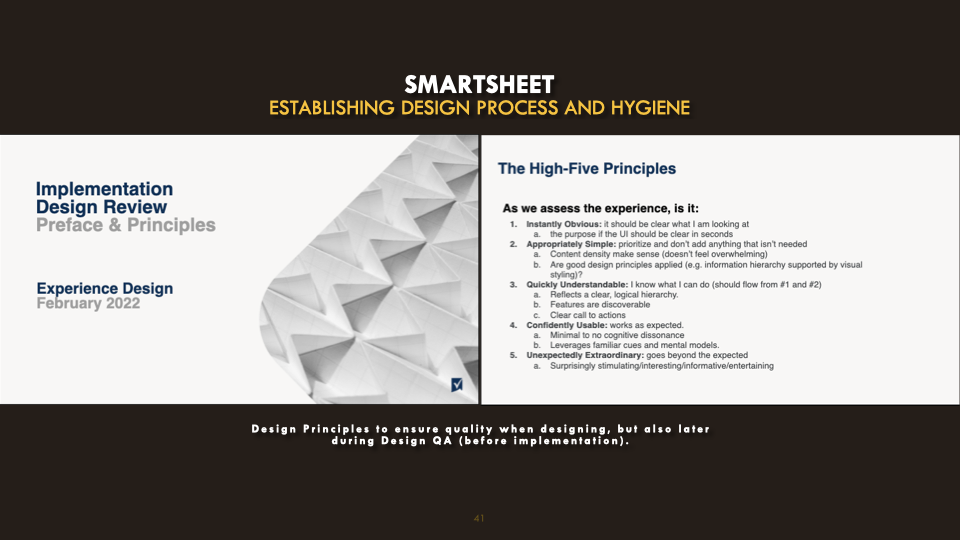
Results
- Stabilized attrition in the pandemic, grew the team during the Great Resignation to ~60 and attracted top design leaders in a hot market (5 directors in about as many months)
- Addressing the lacking design processes and rituals (effective design critiques); defining clear design principles
- Defined and drove processes and accountabilities for better design representation and authority in Agile teams
- Addressing inconsistent/insufficient career management (e.g. no career ladders)
- Established “Guilds” for the ELT to own certain initiatives (e.g. career ladders)
- Closing the gaps on an incomplete new UI direction (Lodestar)
- Stemming the unregulated and organic evolution of the product experience
- Spearheaded initiatives on Information Architecture, Persona-based design, A11y and Design Systems
- Established Experience Analytics / Journey Mapping Team
- Addressing pay inequities (women earning less than their male counterparts). Addressing the lagging pay of current talent while in a hot and competitive market for UX talent
